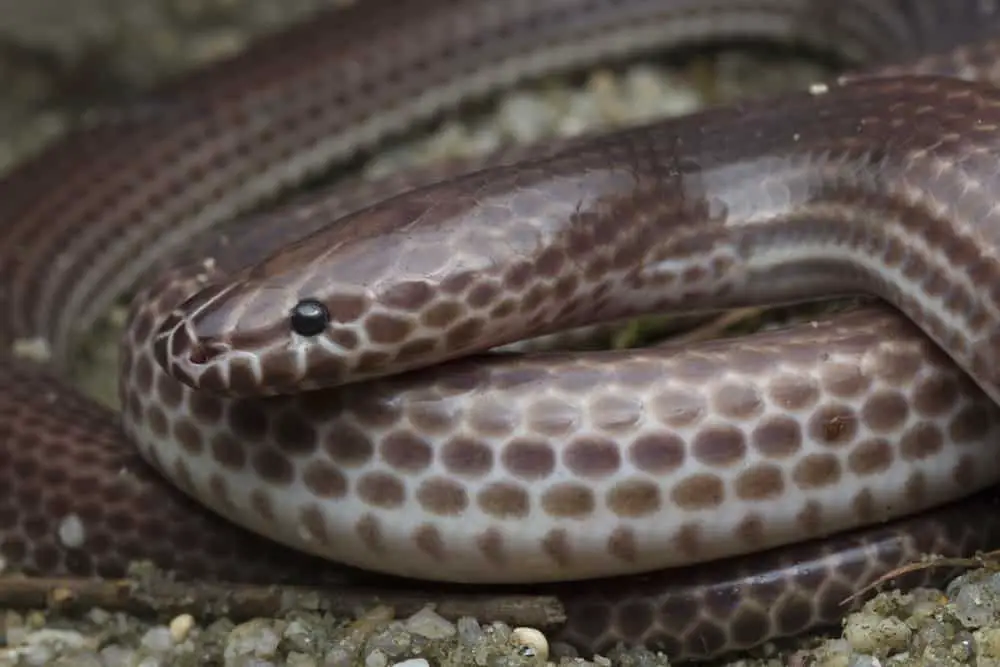
Sunbeam snakes are beautiful, but what makes them so intriguing? Let’s find out why they are so sought after by reptile enthusiasts.
The Common Sunbeam snake and the Hainan Sunbeam snake are the two types of Sunbeam snakes. When Sunbeam snakes slither into the sun, their bodies shine iridescent, like a sunbeam; that’s why they are also called Iridescent Earth snakes.
Sunbeam snakes are fascinating pets; before you go out and get one, it is essential to do a little research about them. In this article, we discuss everything you need to know about these snakes.
Table of Contents
- Common Sunbeam Snakes – Xenopeltis unicolor
- Hainan Sunbeam Snake – Xenopeltis hainanensis
- 16 Points to Remember When Keeping Sunbeam Snakes as Pets
- Types of Food to Feed Sunbeam Snakes
- Conclusion
Common Sunbeam Snakes – Xenopeltis unicolor
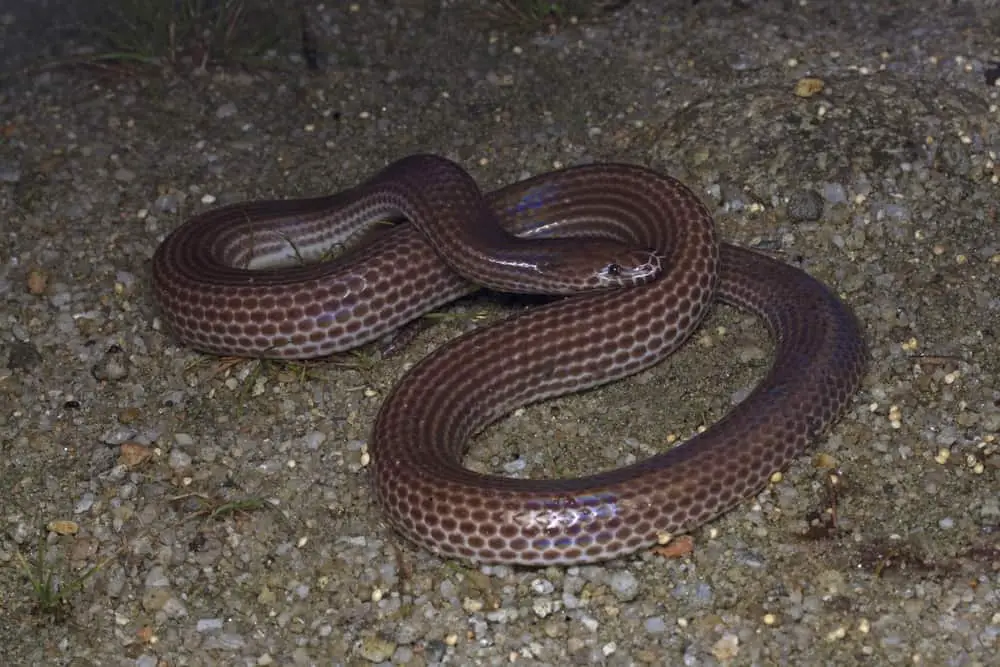
The common Sunbeam snake is not native to the United States. It is found in Southeast Asia in countries like China, Laos, Singapore, Myanmar, Malaysia, Thailand, Cambodia, and some parts of Indonesia.
They belong to the more primitive group of snakes that include pythons and boas. Sunbeam snakes have two lungs instead of one lung found in more modern species and do not have the pelvic girdle.
Their scales overlap with tiny ridges that run along the snake’s body length, reducing the friction that helps when they burrow under the ground.
Common Sunbeam snakes are slender and measure 3 feet long when fully grown that can weigh 2.2 lb. It has a wedge-shaped head, robust body, rounded snout, and small eyes with a short tail. Some records show Sunbeam snakes that grew four feet long.
The wedge-shaped head of the Sunbeam snake helps them dig into the ground when making a burrow and is slightly thinner than their body.
Their brown bodies glow iridescent rainbow colors when in sunlight. When in the shade, the colors on the Sunbeam snake’s back appear black to dark purple. Their scales have a blue, green, yellow, and red sheen when exposed to sunlight.
There are nanostructures that cause the shimmer in their scales which are called iridophores that have microscopic layers that refract light between the scales causing an iridescence.
A thin layer of dark pigment sits just below the scales, highlighting the iridescent sheen giving these snakes a violet or blue undertone. The iridophores are on the top of the scales like a gloss over the melanin layer, which provides the snake with its color.
Iridophores consist of layers of tiny cells that look like crystals that sit on top of each other. Sunlight gets refracted between the layers. When you look at the snake, you see different colors shifting depending on the angle you view them, just like a soap bubble.
Sunbeam snakes were abundant a few thousand years ago. They are one of the oldest reptile species alive and classed by scientists as “relicts.” They have special skeletal structures that are not seen in the other more modern species.
The shape of the mouth and jaw structures of the Sunbeam snake has only been seen on fossils of extinct animals.
Habitat and Diet
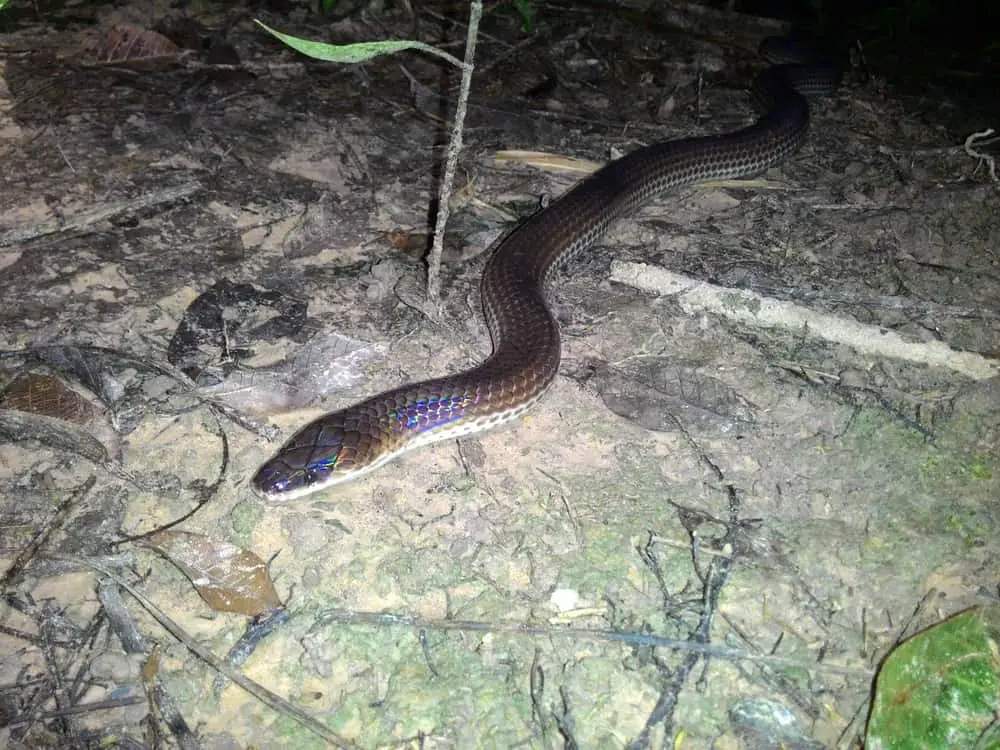
Common Sunbeam snakes live in lowland river valleys, forests, rice paddies, lower mountain forests, and scrublands with the wet, swampy ground.
They like to burrow in mud when hunting for frogs, rodents, shrews, lizards, and moles. Sunbeam snakes are constrictors; they grab their prey with their sharp teeth, coil, and wrap their bodies around the animal, constricting until the prey dies, whereafter it will be swallowed whole.
Other than lizards and rodents, they will also feed on birds and small mammals. They are fast eaters, swallowing their food more quickly than most other snakes.
Other species of snakes do not have teeth in the front of their upper jaw, but Sunbeam snakes do. These teeth let them grab their prey better. The rest of its teeth are hinged at the base of the mouth rather than on the jawbone like other snakes.
Sunbeam snakes are essential to control the overpopulation of rats and mice in nature.
Behavior
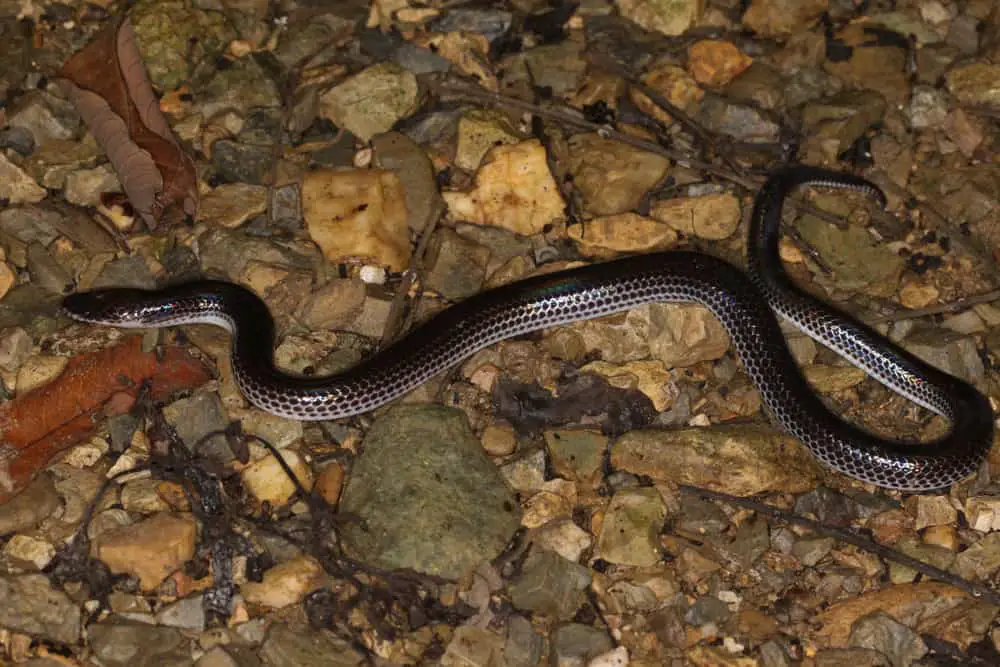
The Common Sunbeam snake is a harmless non-venomous snake. It likes to stay hidden during the day remaining in burrows underground. Even though they can dig out burrows for themselves, they often use abandoned burrows made by other animals.
They will only emerge out from the burrow to hunt. They are solitary animals, not generally aggressive, but will react when handled by excreting a foul-smelling musk that is meant to scare or repulse predators away. Sunbeam Snakes rarely bite but might act in defense when it feels threatened.
They emerge from the burrow to hunt for food at night. Sunbeam snakes are fast-moving snakes that will shake their tails like rattlesnakes when cornered and threatened.
However, they don’t have rattles; the tails are shaking but make no sound. Sunbeam snakes will stiffen their bodies and thrash around when threatened by predators; it won’t harm anyone but might scare them away.
Lifespan
The life expectancy of the Common Sunbeam snake is 10 to 12 years. Female Common Sunbeam snakes can lay between 3 to 18 eggs that will hatch after eight weeks.
Hainan Sunbeam Snake – Xenopeltis hainanensis
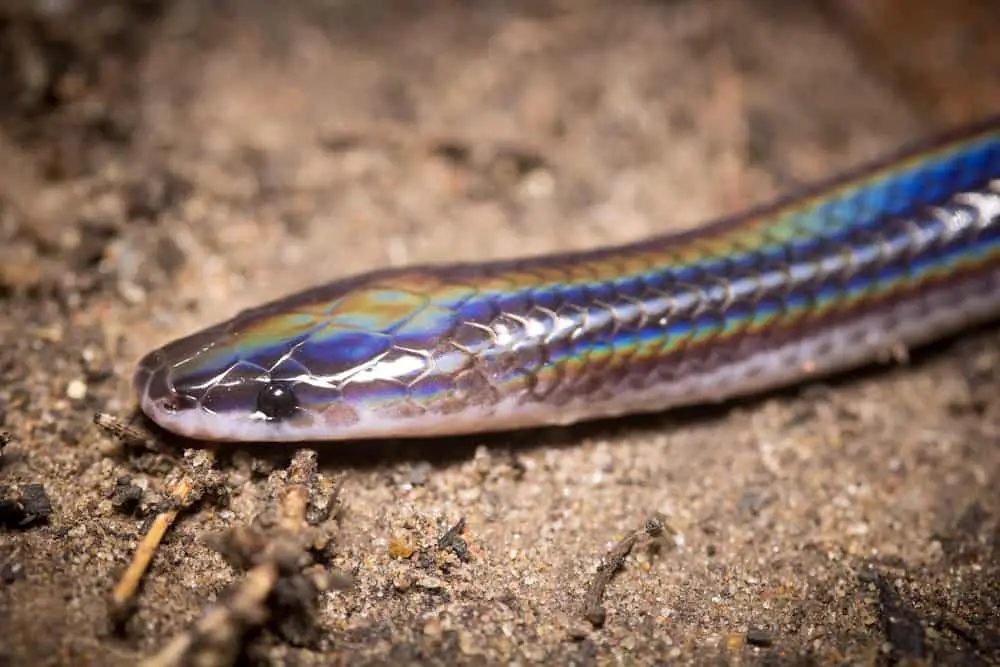
The Hainan Sunbeam snake is a harmless non-venomous snake found in Vietnam and China known for its highly iridescent scales. The Sunbeam snake is classed as a primitive snake species that did not evolve much from its ancestors. Sunbeam snakes look almost like Mexican burrowing snakes.
The Hainan Sunbeam snake measures 1 to 3 feet long when fully grown and can weigh up to 2.2 lb. Its head is wedge-shaped and narrow, which makes it easy to burrow through the ground.
The highly polished iridescent scales are its most defining characteristic that gives this snake its name. On the back of the snake, a dark pigmentation sits just below the surface on each scale that enhances the sheen. The Hainan Sunbeam snake’s ventral scales are greyish-white.
The Hainan Sunbeam snake is different from the Common Sunbeam snake in a few ways. The Hainan Sunbeam snake has one postocular scale rather than two, fewer ventral, infralabial, and supralabial scales, fewer maxillary teeth, and a shorter tail than the Common Sunbeam snake.
Habitat and Diet
Hainan Sunbeam snakes are found in Northern Vietnam and southeastern China from Guangxi to Zhejiang and south to Hainan, where they live on forest slopes at 900 and 1100 meters.
Like the Common Sunbeam snake, the Hainan Sunbeam snake is also a constrictor that suffocates its prey and then swallows it whole. They feed mainly on lizards, frogs, birds, small mammals, and other snakes.
Behavior
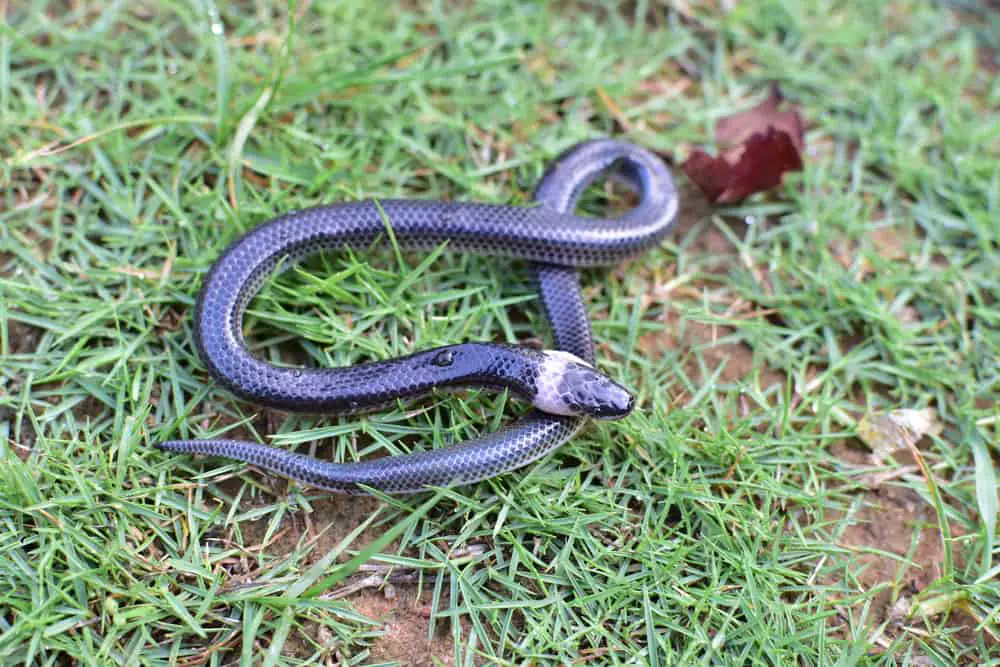
The Hainan Sunbeam snake, just like Common Sunbeam snakes, likes to hide in burrows in the ground during the day. They will come out at night to hunt for food. They are rarely seen because they only come out of the burrow when they want to feed.
Burrowing is a big part of a Sunbeam snake’s life. They move their heads from side to side rather than up and down. This side-to-side motion clears a path when they are burrowing under the ground. The wedged-shaped head also aids this burrowing.
Hainan Sunbeam snakes are solitary and docile but will try to defend themselves by excreting a musk-like substance to repel predators when it feels threatened. They rarely bite, but when picked up and handled too often, they might bite in defense.
Lifespan
The average lifespan of the Hainan Sunbeam snake is 10 to 12 years. The female Hainan Sunbeam snake can lay up to 17 eggs at a time.
16 Points to Remember When Keeping Sunbeam Snakes as Pets
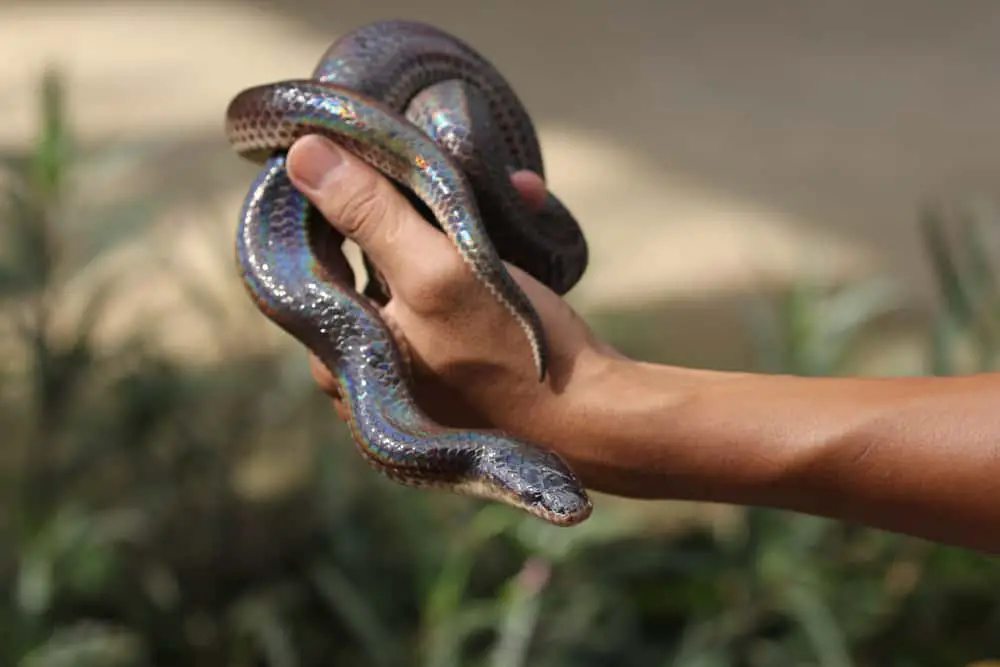
These are some points to remember if you are planning to keep a Sunbeam snake as a pet.
- Generally, Sunbeam snakes cost around $80 to $100.
- The size of the terrarium is important and should provide the snake with enough space. A 40-gallon sized terrarium is a good size.
- Sunbeam snakes are docile and usually don’t try to escape; the terrarium can have front or top openings for easy access. Make sure you close it properly just in case it does decide to sneak out.
- The substrate in the terrarium should allow for burrowing as Sunbeam snakes like the most to burrow in the sand. The dirt should be moist, making it easy for them to burrow.
- You can use finely ground coconut fibers as a substrate mixed with some peat moss, both of which are readily available. The substrate in the terrarium should cover about 6 inches deep.
- The terrarium is the biggest part of taking care of your Sunbeam snake. The terrarium should not be completely wet and muddy all the way through. Keep the terrarium slightly tilted to one side to help keep one area dry.
- Humidity and temperature control are vital to keeping your Sunbeam snake happy and healthy. You can add a heating pad at one end of the terrarium to provide and maintain the correct temperature.
- The perfect temperature setting for the terrarium is 80 degrees Fahrenheit at the lowered side of the terrarium and 70 degrees Fahrenheit at the dry side.
- Keeping the perfect humidity for Sunbeam snakes is crucial; it should be 80% humidity. Humidity is vital for a Sunbeam snake’s health.
- You could add some natural hiding places in the terrarium like some chunky wood logs, twigs, and other things the snakes can hide under. They are not great climbers, so adding branches are for aesthetics only.
- As discussed before, humidity is necessary for your Sunbeam snake to live healthily. Freshwater should always be in the terrarium as they like to stay in water during hot weather. A wide-mouthed bowl of water that can keep the snake immersed is perfect for the terrarium. To keep the water clean and suitable, change it daily.
- Sunbeam snakes don’t breed well in captivity, which is why most Sunbeam snakes in the United States are imported from China.
- When they are imported, Sunbeam snakes undergo stress and can suffer injuries during transportation. They often suffer from internal parasites and blisters when they first arrive. A good topical antibiotic cream can be applied to any blisters or scrapes. De-worming medication should be administered before you start handling them.
- You can find Sunbeam snakes to purchase online or at any reptile exhibition.
- Once your Sunbeam snake starts feeding regularly, it is a sure sign that it recovered from the transportation.
- Sunbeam snakes are docile but don’t like to be disturbed a lot; it stresses them out. Try to handle your Sunbeam snake as little as possible. If you want a snake to cuddle and hold every day, you should rather get another type of snake.
Types of Food to Feed Sunbeam Snakes

Sunbeam snakes feed on frogs, toads, lizards, mice, and other snakes. When keeping a Sunbeam snake as a pet, you can feed it frozen mice that can be thawed before feeding.
You should feed it one to two adult mice per week. If your Sunbeam snake is small and under 2 feet, feed it smaller prey animals like fuzzy mice.
It is a good idea to feed your snake 2 or 3 smaller mice because they can’t open their mouths as big as other snakes. For them eating a few smaller mice is better than eating one large meal at a time.
If your Sunbeam snake doesn’t want to eat thawed mice, try feeding them live mice. Stick to a routine feeding schedule and document the feedings to keep track of when your snake ate last.
Juvenile Sunbeam snakes need to be fed once a week, while adult fully grown Sunbeam snakes need to be fed once every two weeks.
Conclusion
We hope the types of Sunbeam snakes we listed above will give you some insight into these wonderful old-world reptiles with their beautiful sheen.
Both Sunbeam species are incredibly eye-catching when exposed to natural sunlight, where their luminescence comes to life with a beautiful rainbow sheen. Characteristically Sunbeam snakes do not like to be disturbed much, and even though reptile enthusiasts keep them as pets, they are not cuddly snakes.
They prefer to hide under the ground for most of the time in burrows and only come out to feed. They are essential to a healthy ecosystem where they keep excess rats and mice in control.
If you provide the Sunbeam snake with the right environment, they can be kept as pets but note they are not native to the United States and must be imported from China.
Sources:
Reptiles Cove: Sunbeam Snakes
Encyclopedia: Sunbeam Snakes Xenopeltidae
My Snake Pet: Sunbeam Snake Care (Ultimate Guide For Beginners And General Info)



